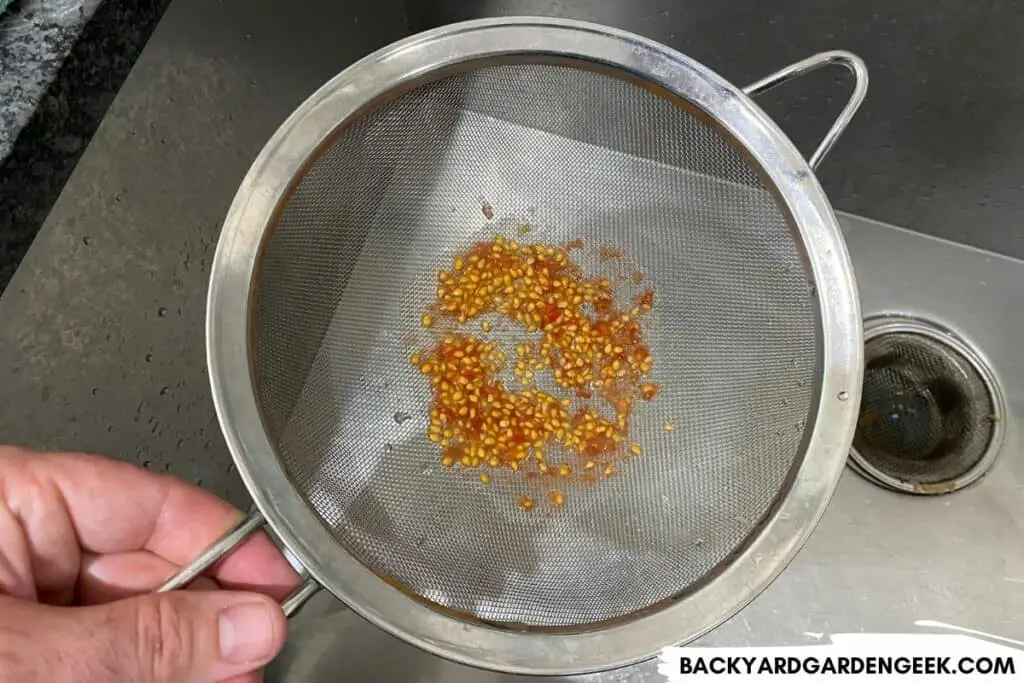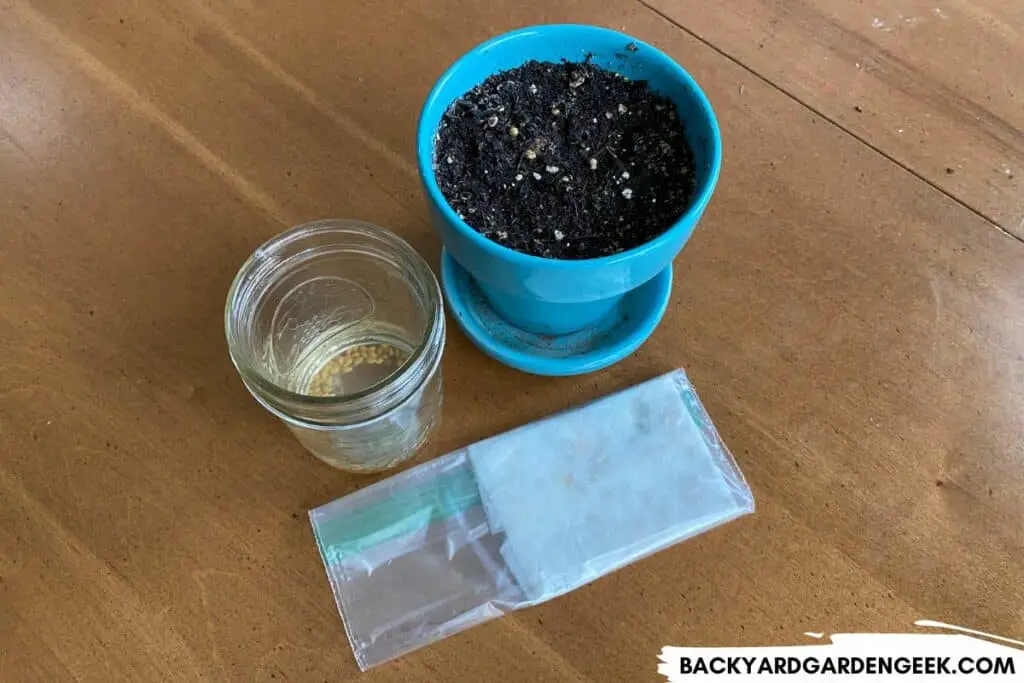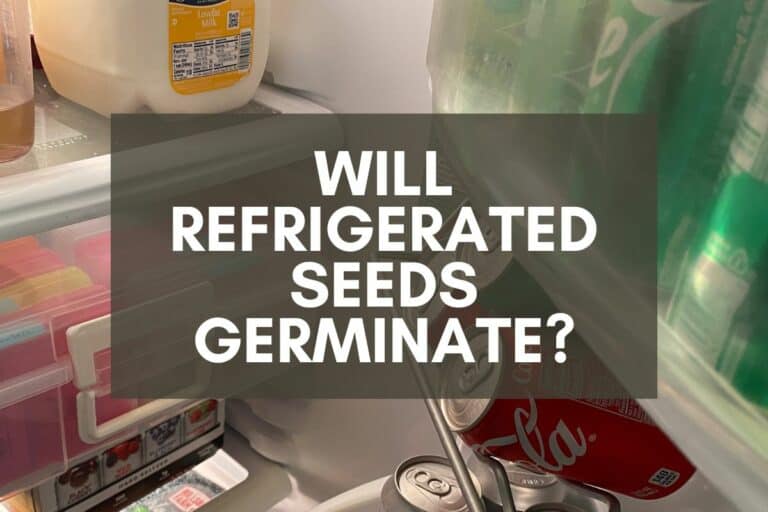Planting Seeds from Canned Tomatoes: Will It Work?
Have you ever opened a can of whole tomatoes, taken a tomato out, and wondered, ”Can I plant these seeds?”
If you’ve ever wondered about planting canned tomato seeds, there’s no need to do any more googling since I conducted an experiment recently to see, once and for all, if I could germinate a single seed from canned tomatoes. Here’s what I learned.
Seeds from canned tomatoes won’t germinate and thus can’t be planted because they’ve been exposed to boiling temperatures (212℉ / 100℃) as part of the canning process. Boiling water shuts down all active enzymes to preserve canned tomatoes, but it’ll also scorch seed embryos and sterilize them.
I’ve seen various bloggers say something similar (although mostly without any evidence), so I wanted to see for myself if I could germinate just one seed from a few jars of canned tomatoes.
What I’d like to do is to share what I’ve learned in my attempts to germinate canned tomato seeds, but I’d also like to share additional information about growing tomatoes from store-bought tomatoes and refrigerated tomatoes so that you can know more about growing plants from tomato seeds.
So here’s what I’ll cover in this article:
- What You Should Know About Canned Tomato Seeds
- Will Seeds from Store-Bought Tomatoes Grow?
- Can You Save Seeds from Refrigerated Tomatoes?
Once you’ve read this article, you’ll have a general understanding of why some seeds grow while others don’t plus various tips and suggestions for germinating seeds successfully.

My Experiment with Canned Tomato Seeds: Here’s What Happened
When it comes to canning tomatoes, what you need to understand is that the canning process requires very high levels of heat, typically boiling water. The reason for this is the active enzymes that are at work inside the tomato. If those enzymes aren’t neutralized, tomatoes will spoil if stored for long periods of time.
This got me thinking: Would it be possible for even a single seed to survive the canning process and germinate successfully?
I had a feeling that the answer was going to be “no,” but I wanted to run my own test to see if I could coax any life out of canned tomato seeds. Here’s what I did:
First, I went to the grocery store and bought several cans of whole tomatoes. I knew I needed whole tomatoes since the seeds are mostly removed from cans of diced tomatoes, tomato sauce, and tomato paste.

Next, I went through the process I normally use when harvesting seeds from tomatoes. I removed the seeds from the tomatoes and put them in a wire mesh strainer. I then rinsed everything with water while gently rubbing seeds around the strainer. That will normally separate the gel from the seed and aid in the germination process.
Once my seeds were thoroughly rinsed and ready for attempted germination, I tried 3 different germination methods to see if any of them would do anything.
The first method involved planting seeds in some soil. Normally, I’d plant seeds in seed cells, but in this instance, I wasn’t trying to grow new plants. I just wanted to see if any seeds would germinate.
For the second method, I placed quite a few seeds in water since water can help with germination. I’ll explain below why the water that’s used in the canning process actually works to neutralize seeds, but I thought I’d try it anyway since it’s a popular way to germinate seeds.
Finally, I placed numerous seeds in a slightly damp paper towel, folded it over several times, and sealed it up in a plastic Ziploc bag.

If you’ve used these methods to germinate seeds from a seed supplier or from your own homegrown tomatoes, you should start to see a tiny whitish point emerge from your seeds in 3-5 days. That’s the radicle, the seed’s first root, and it means your seeds have successfully germinated.
So what did I see from the canned tomato seeds after waiting several days?
Nothing. I saw absolutely nothing. As I had initially suspected, the seeds were utterly devoid of life, having been scorched during the tomato canning process.
Canned Tomato Seeds: Why Won’t They Germinate?
Now that I’ve covered what I did, let’s look at what happens during canning, and why it’s highly unlikely that anyone anywhere can germinate seeds from canned tomatoes.
There are actually several ways to go about canning tomatoes, but here’s the most important thing to understand: When tomatoes are exposed to high temperatures (such as boiling water), the seeds’ active enzymes are neutralized, which makes it possible for whole tomatoes to be stored for long periods of time.
Beyond exposure to extremely high temperatures, there’s one other reason why seeds from canned tomatoes won’t germinate, and this has to do with the water that’s used as part of the canning and storage process.
For germination to occur, the outer shell of the seed (known as the testa) must soften up so that the plant’s first root (the radicle) and its first leaves (known as cotyledons) can push through the seed shell and into the soil.
If you’ve never seen this sort of thing, I’ve written an article about what tomato seeds and seedlings look like, and you can find several tomato-related photos there.
For the softening of the testa to occur, seeds must be exposed to moisture and warmth, which signal to the seed that conditions are right for germination.
Although germination most often occurs in warm, moist soil, you can easily germinate tomato seeds in water or even wet paper towels. In fact, I’ve done so myself plenty of times. What’s interesting is that tomato seeds don’t need sunlight to germinate because warmth and moisture are all that’s required.
But let’s look at this in the context of the tomato canning process. After the seeds have been exposed to boiling water and extreme temperatures, they’re then submerged in water and canned.
Let’s say, as a thought experiment, that a few seeds survived the canning process unscorched, maintaining their viability despite the extreme temperatures. In the extremely rare off-chance that several seeds retained their growth potential despite being exposed to boiling temperatures, those seeds would then be submerged in water for weeks, or likely months, before the cans ever hit the shelves of your local grocery store.
By the time you get your hands on a jar of canned tomatoes, the seeds will have been sitting in water for so long that there’ll be no possibility of life left in them.
Even if a radicle did manage to somehow emerge from the seed after the canning process had taken place (which is still highly unlikely), that tiny root would soon rot since there’s no soil or nutrients to encourage further plant growth.
Between the scorching heat and the extended water bath, seeds from canned tomatoes will never germinate. There’s just too many strikes against them.
Will Seeds from Store Bought Tomatoes Grow?
The same doesn’t apply to seeds harvested from store-bought tomatoes.
Store-bought tomatoes may not have the flavor qualities of homegrown tomatoes–because they’ve been bred to look good and stand up under the strain of extended supply chains–but they’ve got life in them that canned tomatoes don’t.
Seeds from store-bought tomatoes will germinate as readily as seeds harvested from homegrown tomatoes or purchased from garden centers and online seed suppliers. However, store-bought tomatoes are often hybrid tomatoes, which means their seeds won’t produce an exact replica of the original plant.
I’ve experimented with and written about growing tomatoes from hybrid tomato seeds, and here’s what I’ve realized: Growing plants from store-bought tomato seeds can be fun but only under certain conditions.
Before you try doing so, ask yourself these questions:
- Do you enjoy experimenting in your garden, even when something doesn’t turn out the way you had hoped for?
- Do you like growing new tomato varieties, especially ones you’ve never tasted before?
- Do you have room in your garden for one or more additional plants?
The thing about harvesting store-bought tomato seeds is that you never know what’s going to happen.
I harvested seeds from store-bought Kumato tomatoes a few years back because I liked the taste and thought I’d see what happened if I grew my own from seed.
I knew I was harvesting and planting hybrid seeds, but I thought it was worth a try and wanted to experiment.
Things went well for the first few months. The seedlings grew normally, and the developing fruit looked great. But the first odd thing I noticed was that the fruit didn’t quite ripen the way I expected it to.
The bottom half of the tomatoes turned a nice deep brown just like the Kumato tomatoes I had bought at the store, but the tops of the tomatoes stayed green for far longer.
When I finally harvested the fruit, the differences were immediately noticeable.
The original Kumato tomatoes were sweet and had a little tangy zing to them. Mine were anything but sweet or tangy and had no zing at all. The skins were rather thick, the tomatoes weren’t as meaty as the originals, and the overall taste was bland and unappealing.
Did I like the plant that I had grown from store-bought tomatoes? No, not really.
Did I enjoy the time I spent growing a uniquely weird Kumato-like variant? Absolutely.
I don’t plan on harvesting any seeds from store-bought tomatoes this year, but I can definitely see myself experimenting again sometime down the road since I had fun the first time.
Can You Save Seeds from Refrigerated Tomatoes?
Much like store-bought tomatoes, tomatoes that have been refrigerated will have viable seeds inside of them.
When tomatoes are canned, the extreme heat will irreparably damage the seeds, which means they’ll not germinate no matter what conditions they’re exposed to, whether that’s soil or water or paper towels.
Refrigeration is different. When tomatoes are put in the refrigerator, the seeds will retain their viability, but they’ll remain dormant because, in the vast majority of instances, the conditions aren’t right for germination.
On very, very rare occasions, you might notice that seeds have sprouted inside a tomato. This typically happens when tomatoes are left on warm kitchen counters or exposed to warming temperatures in some other way. Unless they had already sprouted when you harvested the tomato or purchased it at the grocery store, you shouldn’t expect anything like this to happen if you’ve stored your tomatoes in the refrigerator.
Additional Reading
I love tomatoes and write about them often. If you’d like to read more about tomato seeds and seedlings, check out these related articles:







